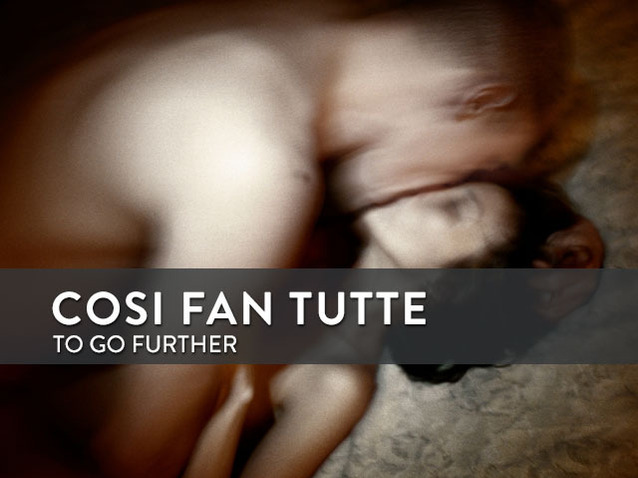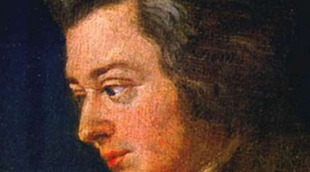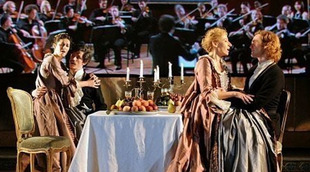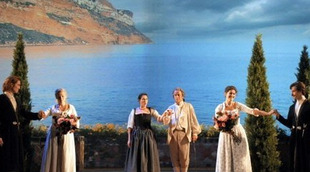 © DR
© DR
Historically, the Festival of Aix-en-Provence lets a large place for Mozart's works, and to open its 2016 edition this Thursday, the festival will play a new production of Così fan Tutte set by the filmmaker Christophe Honoré (who transposes the action in the african setting of the mussolinian Eritrea of the colonial late 30s) with Kate Lindsey and Sandrine Piau. To better prepare, we return to the origins of this Mozart's opera (for his latest collaboration with the librettist Da Ponte) which under the guise of "musical banter" appears as a real initiatory journey revealing to each of the protagonists his own identity.
***

After The Marriage of Figaro (1786) and Don Giovanni (1787), Mozart and Lorenzo Da Ponte came together one last time to work on Cosi fan tutte, an opera “buffa” subtitled “School for Lovers”. The last opus in the famous “trilogy” is the one that caused the greatest misunderstandings, requiring countless attempts at more or less convincing interpretations. Almost unanimously rejected in the 19th century, Cosi seems better attuned to our disenchanted times when we are of course accustomed to doubting the sincerity of passionate hearts. But while our contemporary penchant for scepticism and questioning about certain moral values criticises us for this musical badinage, it remains a formidable obstacle. To fully appreciate the bitter charm of this painful “sentimental education:, we must give up the idea of verisimilitude and agree to enter, with no second thoughts, a purely conventional world, which was so much appreciated in the 18th century But would it not be a curious paradox to want to decry the absurdity of a plot in the name of a completely illusory realism in opera, the art of convention par excellence? As an experienced and talented librettist, Da Ponte made use of all the resources provided by typical situations that were very much in vogue at the time. They can be considered frivolous and cynical, condemning a wager on a woman’s fidelity and rejecting the misrepresentation of the lovers, making a seduction mix-up possible. Is there any depth behind all these appearances? The proceedings and the characters seem to suffer from a certain oversimplification associated with the desire to show that love is not a game of fools. The rigour of the demonstration contrasts with the beauty and poetry of the music. Blending irony and sincerity, Mozart excels at expressing the most hidden hopes and contradictions of the human soul trapped in the nets of the game of love and chance.
Multiples Sources
We have very little information about the origins of Cosi fan tutte, which adds to the mystery. A review of Mozart’s abundant correspondence reveals nothing in particular, and it would be risky to look for an autobiographical dimension in this plot worthy of Liaisons dangereuses ! We must not look for insights into the musician’s married life. Surprisingly, Lorenzo Da Ponte (1749-1838) is no more verbose in his Memoirs. He devotes only two lines to the work, designated only by its subtitle, to mention his mistress, singer Adriana Ferrarese, who created the role of Fiordiligi: “For her I wrote (…) ‘La Scuola degli amanti’ set to music by Mozart, a work which, chronologically, is the third among its sisters born from this very famous father of harmony”.
In August 1789, the triumphant revival in Vienna of The Marriage of Figaro at theBurgtheater earned Mozart a commission for a new opera. It is claimed that Joseph II himself had suggested taking as subject an actual event that had happened in Viennese high society: that seems unlikely Da Ponte simply revived a theme as old as the world: a denunciation of the inconstancy of women considered incapable of remaining faithful to their vows of love. “Women change their minds so often, you’d have to be mad to trust them” as the good king François Imight have said.” “La donna è mobile”, as another famous seducer sang in Verdi’s Rigoletto . Making an entire opera out of such a simple, if not simplistic, topic may seem a real challenge. Although the plot’s development is not based on a prestigious model as was the case, for example, with The Marriage of Figaro, adapted by Beaumarchais, Cosi borrows just as much from different sources. Most of the librettos by Da Ponte, a man of great learning, are more or less direct adaptations of previous works. Cosi was no exception to this, and in it we find many sources: poetry, drama, novels. The wager on a woman’s fidelity and the lover’s disguising himself in order to put it to the test are typical situations that can be found in the works of Ovid, Boccacio and Shakespeare. Goethe, Laclos and Goldoni had made them popular once again. Don Alfonso wants to demonstrate to Ferrando and Guglielmo that their fiancées are not as irreproachable as they had imagined, and all they had to do was to court each other’s fiancées in order to have their illusions shattered. Disguise drives the action by making it possible to demonstrate the validity of the initial premise. This procedure had been widely used in the theatre and opera since the 17th century, and Mozart had previously used it in La finta giardiniera (1775), The Marriage of Figaro(1786) and Don Giovanni (1787).
The title Cosi fan tutte, “all alike”, seems to echo a phrase used in The Marriage of Figaro by Basilio who plays the go-betweens with Susanna, advising her to give in to Count Almaviva. In the trio “Cosa sento” (Act 1, Scene 7), Basilio states philosophically: “Cosi fan tutte le belle! Non c’è alcuna novita” (“All beautiful women are like that. It’s nothing new”).
The operawas written and composed quickly. In a few months the musician was ready to present the work on the piano, with Haydn in attendance. Cosi successfully opened on 26 January 1790, on the eve of the composer’s thirty-fourth birthday . Unfortunately, the death of Emperor Joseph II on 20 February led to the closing of the theatres. At the end of the mourning period, Cosi was staged only five or six times before it disappeared for some thirty years.
Rejection and Incomprehension
The work’s real resurrection came in the 20th century; the 19th century had not been kind to Cosi! It is fair to say the work was genuinely misunderstood throughout the Romantic period. Such iconoclastic lightness and impertinence were no longer popular, and to save Mozart’s music people went so far as to dissociate it from a libretto so frivolous it was beyond saving. Stendhal stated that: “the work ‘Cosi fan tutte’ was done for Cimarosa and is quite contrary to the talent of Mozart, who could not trifle with love”.

Like Beethoven before him, Wagner rejected this farce, finding it amoral and full of improbabilities. Wagner was actually happy that Mozart had not written a score as beautiful as that of The Marriage of Figaro for such a libretto: “What a shame it would have been for music!”. The famous Viennese critic Eduard Hanslick (1825-1904) for once agreed with Wagner, pointing to the plot’s incoherence:
“Is there a more indulgent subject in all of opera? Is there a more absurd way to call on the audience’s credulity, by requiring that they accept the blindness of the two heroines: they do not recognise their lovers, whom they were caressing half-an-hour earlier; they even take their own maid, in a wig, as a physician or lawyer? (…) I consider ‘Cosi’ not viable on a stage today.”
This type of judgement led to adaptations that mutilated the work. In 1863, Jules Barbier and Michel Carré, librettists for Goundod’s Faust (1859), did not hesitate to adapt Mozart’s score to Shakespeare’s Love’s Labour’s Lost by re-creating a comic opera in four acts that looks exactly like a Spanish inn! In the 19th century, one could hardly imagine a life lesson from the disconcerting superficiality that was attributed to Da Ponte.
Appearances and Depth
The work is unique in being the longest of Mozart’s operas, while presenting the most concentrated action. There are only six characters in this almost geometrically rigorous plot. The dramatic progression follows the logic of well-designed mechanics: the two couples, together or separately, test their illusory solidity in perfectly balanced scenes.Cosi is an ensemble opera, especially in the first act, where we are in farce mode. As soon as the game becomes destabilising, the characters leave behind their puppet status for a few moments of introspection, where their singing becomes individual, making them beings of flesh and bone.
Developing the initial theorem of Don Alfonso, the demonstration proceeds to its conclusion, to the detriment of the unhappy participants beset by pangs of doubt, then by the bitterness of said reality. The philosopher’s assistant and accomplice is a Despina now over all illusions: “What is love? Pleasure, approval, fantasy, joy, amusement, pastime, gaiety…” (Act 1, Scene 13). By making feminine infidelity the subject of a bet between an old philosopher and two young lovers, Da Ponte added an educational element to his plot, elevated to the level of a veritable initiation. Don Alfonso is the merciless instigator of a cruel game that gradually reveals to each character their own identity, or in other words their own weaknesses. The two women and the two men follow a sentimental and moral evolution, going from forgetting their first loves to the birth of a new love. Stiff and ridiculous theatrical characters, the protagonists gradually take on a human dimension as they reveal themselves to themselves. The initial configuration went against established custom: against every expectation, the teno loved the mezzo, the baritone loved the soprano. The two high-pitched voices and the two low-pitched voices end up coming together, and the couples then seem better matched. The natural harmony of the voices will briefly underwrite a new love: the soprano Fiordiligi’s love for the tenor Ferrando, and mezzo Dorabella’s love for the bass Guglielmo.
Cosi achieves a subtle balance between the conventions on which it is based and the sincerity that Mozart’s music instils in them. Behind the excesses of fable, a human truth tries to declare itself, or, more precisely, to sing itself. In his Memoirs, Da Ponte states that his goal was to rescue opera “buffa” from its mediocrity, and it is reasonable to think he achieved this perfectly with Mozart’s help. In Cosi we find all the elements typical of the genre, reprised and orchestrated with a lightness and elegance that are far removed from the spirit of farce. The common aspects of opera “buffa” are transcended to produce a resolutely new opera. Feminine fidelity put on trial, the simplicity of the plot, the old philosopher and the saucy soubrette like fickle pairs of lovers, all that is part of the mandatory aspects of opera “buffa”. It constantly borders on parody. The text manipulates double entendres and misunderstandings, going so far as to blend the dramatic register of opera “seria” with that of opera “buffa” when the protagonists mimic noble sentiments.
What creates unease in the spectator always looking for a positive outcome is the indecision we are left with by Da Ponte and Mozart. What “moral” are we to draw from this dangerous game? The dénouement does not, as we would have expected, crown the birth of two new couples created out of a back-and-forth game of sentiment that is, in the end, welcome. Don Alfonso asks the two men to marry the women to whom they were betrothed despite the evidence of their betrayal. Irony and indulgence seem to get the better of the two young men’s regrets, while the two sisters express their disenchantment with a resigned and deceptive tenderness. But these new promises of happiness, the result of a cruel wisdom, have the bitter taste of disillusion and suffering.
Musical Truth

The mysterious charm of Cosi comes from the permanent disconnect established between the subject matter and the score. Nothing is able to completely dispel the obsessive contradiction separating the music from the frivolity of a seemingly inconsistent plot. And so the emotion raised by the magnificent trio “Soave sia il vento” (Act 1, Scene 6) that carries us away in a dreamy melancholy, whereas the situation belongs in the comedy register. The spectator knows full well that he is being shown two scatterbrains shedding crocodile tears as they watch as their lovers, who are playing a trick on them at the instigation of an unscrupulous manipulator. We are far from the goodbyes of Titus and Bérénice and yet we are greatly moved by irresistible nostalgia for the happiness that is being lost forever. We are also disturbed by this dissonance that can be heard when there is talk of “desire”: “And let each element correspond favourably to our desires”. Disillusion is already at work.
Ambiguity dominates this opera; we have no idea what impression to take away from it. Are we to “understand” that, after this game that becomes a cruel trial, the lovers will achieve a new serenity? Will they be “philosophically” resigned to the fragility of feelings, the erosion of time and the inevitable forgetting? Perhaps we just need to be guided by Mozart’s music, filled with gaiety and sadness. In his Thomas Graindorge (1867), Taine sees music as the solution to all contradictions : “The piece has no common sense, and so much the better. Does a dream have to be plausible? (…) I will do as the musician does: I will forget the plot. The piece is satirical and silly; along with Mozart, I want to see it as sentimental and tender On the stage there are two Italian flirts laughing and lying; but in the music, no one laughs and no one lies; at the very most, someone smiles; even tears are close to, smiles.” And the smile has something of the politeness of despair about it.
Catherine Duault
the 28 of June, 2016 | Print



Comments